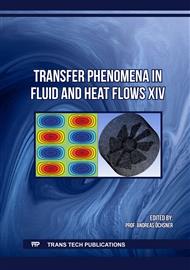[1]
M.F. Modest, Radiative Heat Transfer, third ed., Elsevier, New York, 2013.
Google Scholar
[2]
M. Frank, M. Seaïd, A. Klar, R. Pinnau, G. Thömmes and J. Janicka, A comparison of approximate models for radiation in gas turbines, Prog. Comput. Fluid Dyn., 4 (2004) 191-197.
DOI: 10.1504/pcfd.2004.004087
Google Scholar
[3]
E.W. Larsen, G. Thömmes, A. Klar, M. Seaïd and T. Götz, Simplified PN approximations to the equations of radiative heat transfer and applications, J. Comput. Phys., 183 (2002) 652-675.
DOI: 10.1006/jcph.2002.7210
Google Scholar
[4]
R. Viskanta and M.P. Mengüç, Radiation heat transfer in combustion systems, Prog. Energy Combust., 13 (1987) 97-160.
Google Scholar
[5]
E. Meinköhn and S. Richling, Radiative transfer with finite elements: II. Ly line transfer in moving media, Astron. Astrophys., 392 (2002) 827-839.
DOI: 10.1051/0004-6361:20020951
Google Scholar
[6]
S. Richling, E. Meinköhn, N. Kryzhevoi and G. Kanschat, Radiative transfer with finite elements: I. Basic method and tests, Astron. Astrophys., 380 (2001) 776-788.
DOI: 10.1051/0004-6361:20011411
Google Scholar
[7]
G.S. Abdoulaev and A.H. Hielscher, Three-dimensional optical tomography with the equation of radiative transfer, J. Electron. Imaging, 12 (2003) 594-601.
DOI: 10.1117/1.1587730
Google Scholar
[8]
A.H. Hielscher, R.E. Alcouffe and R.L. Barbour, Comparison of finite-difference transport and diffusion calculations for photon migration in homogeneous and heterogeneous tissues, Phys. Med. Biol., 43 (1998) 1285-1302.
DOI: 10.1088/0031-9155/43/5/017
Google Scholar
[9]
T. Tarvainen, M. Vauhkonen and S.R. Arridge, Gauss–Newton reconstruction method for optical tomography using the finite element solution of the radiative transfer equation, J. Quant. Spectrosc. Radiat. Transf., 109 (2008) 2767-2778.
DOI: 10.1016/j.jqsrt.2008.08.006
Google Scholar
[10]
L.V. Wang, and H. Wu, Biomedical Optics: Principles and Imaging, first ed., John Wiley & Sons, Inc., New Jersey, 2007.
Google Scholar
[11]
R.F. Knackfuss and L.B. Barichello, On the temperature-jump problem in rarefied gas dynamics: the effect of the Cercignani-Lampis boundary conditon, SIAM J. Appl. Math., 66 (2006) 2149- 2186.
DOI: 10.1137/050643209
Google Scholar
[12]
E.E. Lewis, and W.F. Miller, Computational Methods of Neutron Transport, first ed., John Wiley & Sons, Inc., New York, 1984.
Google Scholar
[13]
W.M. Stacey, Nuclear Reactor Physics, second ed., Wiley-VCH, Weinheim, 2007.
Google Scholar
[14]
J.R. Howell, M.P. Mengüç, K. Daun and R. Siegel, Thermal Radiation Heat Transfer, seventh ed., CRC Press, Boca Raton, 2021.
Google Scholar
[15]
J.C. Chai, H.S. Lee and S.V. Patankar, Ray effect and false scattering in the discrete ordinates method, Numer. Heat Transf. B: Fundam., 24 (1993) 373-389.
DOI: 10.1080/10407799308955899
Google Scholar
[16]
J.E. Morel, T.A. Wareing, R.B. Lowrie and D.K. Parsons, Analysis of ray-effect mitigation techniques, Nucl. Sci. Eng., 144 (2003) 1-22.
Google Scholar
[17]
H.-S. Li, G. Flamant and J.-D. Lu, Mitigation of ray effects in the discrete ordinates method, Numer. Heat Transf. B: Fundam., 43 (2003) 445-466.
DOI: 10.1080/713836241
Google Scholar
[18]
L.K. Abu-Shumays, Angular quadratures for improved transport computations, Transp. Theory Stat. Phys., 30 (2001) 169-204.
DOI: 10.1081/tt-100105367
Google Scholar
[19]
L.B. Barichello, A. Tres, C.B. Picoloto, Y.Y. Azmy, Recent studies on the asymptotic convergence of the spatial discretization for two-dimensional discrete ordinates solutions, J. Comput. Theor. Transp., 45 (2016) 299-313.
DOI: 10.1080/23324309.2016.1171242
Google Scholar
[20]
B. Hunter and Z. Guo, Comparison of quadrature schemes in DOM for anisotropic scattering radiative transfer analysis, Numer. Heat Transf. B: Fundam., 63 (2013) 485-507.
DOI: 10.1080/10407790.2013.777644
Google Scholar
[21]
R. Koch and R. Becker, Evaluation of quadrature schemes for the discrete ordinates method, J. Quant. Spectrosc. Radiat. Transf., 84 (2004) 423-435.
DOI: 10.1016/s0022-4073(03)00260-7
Google Scholar
[22]
J.J. Jarrel, An Adaptive Angular Discretization Method for Neutral-Particle Transport in Three- Dimensional Geometries, Ph.D. thesis, Texas A&M University, 2010.
Google Scholar
[23]
J.C. Stone, Adaptive Discrete-Ordinates Algorithms and Strategies, Ph.D. thesis, Texas A&M University, 2007.
Google Scholar
[24]
J. Tencer, Ray Effect mitigation through reference frame rotation, J. Heat Transfer., 138 (2016) 112701-112712.
DOI: 10.1115/1.4033699
Google Scholar
[25]
P.H.A. Konzen, L.F. Guidi and T. Richter, Quasi-random discrete ordinates method for neutron transport problems, Ann. Nucl. Energy, 133 (2019) 275-282.
DOI: 10.1016/j.anucene.2019.05.017
Google Scholar
[26]
G. Leobacher, and F. Phillichshammer, Introduction to Quasi-Monte Carlo Integration and Applications, first ed., Birkhäuser, Heidelberg, 2014.
Google Scholar
[27]
P.H.A. Konzen, L.F. Guidi and T. Richter, Quasi-random discrete ordinates method to radiative transfer equation with linear anisotropic scattering, in: Anais do Encontro Nacional de Modelagem Computacional, Encontro de Ciência e Tecnologia de Materiais, Conferência Sul em Modelagem Computacional e Seminário e Workshop em Engenharia Oceânica, UFPel/ FURG/UNIPAMPA, Pelotas, Brazil, 2022, available on https://www.even3.com.br/anais/enmcmcsulsemengo2022/ 534616-quasi-random-discrete-ordinates-method-to-radiative-transferequation- with-linear-anisotropic-scattering/
DOI: 10.29327/1142685
Google Scholar
[28]
P.H.A. Konzen, L.F. Guidi and T. Richter, QRDOM's ray effect mitigation to particle transport problems with anisotropic scattering, in: Book of Abstracts of the LACIAM 2023, FGV, Rio de Janeiro, Brazil, 2023, p.155.
Google Scholar
[29]
B. Vandewoestyne and R. Cools, Good permutations for deterministic scrambled Halton sequences in terms of L2-discrepancy, J. Comput. Appl. Math., 189 (2006) 341-361.
DOI: 10.1016/j.cam.2005.05.022
Google Scholar
[30]
G. Kanschat, A robust finite element discretization for radiative transfer problems with scattering, East-West J. Numer. Math., 6 (1998) 265-272.
Google Scholar
[31]
R. Becker, M. Braack, D. Meidner, T. Richter and B. Vexler, The Finite Element Toolkit Gascoigne 3D, 2021, available on (10.5281/zenodo.5574969) https://www.gascoigne.de
Google Scholar
[32]
M.A. Badri, P. Jolivet, B. Rousseau and Y. Favennec, High performance computation of radiative transfer equation using the finite element method, J. Comput. Phys., 360 (2018) 74-92.
DOI: 10.1016/j.jcp.2018.01.027
Google Scholar
[33]
D. Le Hardy, Y. Favennec, and B. Rousseau, Solution of the 2-D steady-state radiative transfer equation in participating media with specular reflections using SUPG and DG finite elements, J. Quant. Spectrosc. Radiat. Transf., 179 (2016) 149-164.
DOI: 10.1016/j.jqsrt.2016.03.027
Google Scholar


